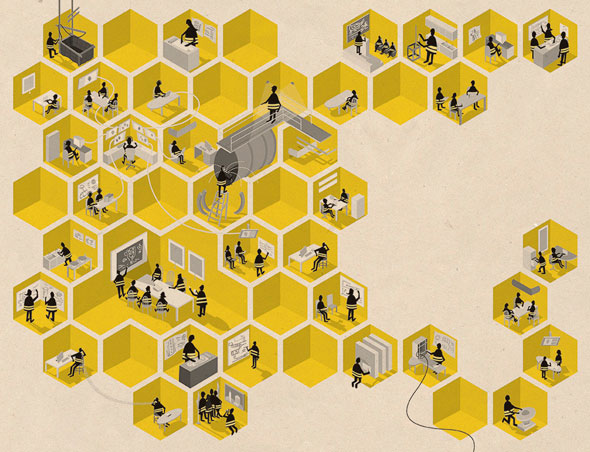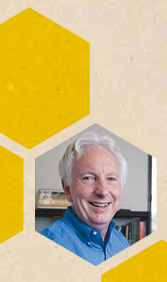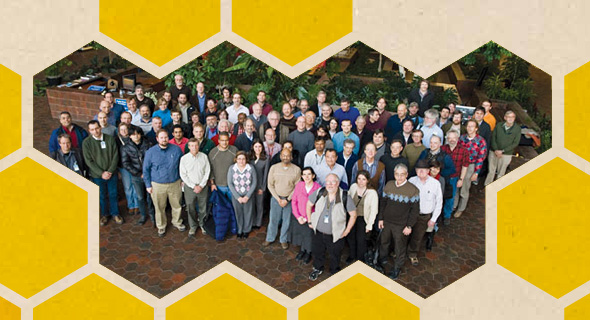LBNE: The inside buzz on a new science project
Planning and designing the $900 million Long Baseline Neutrino Experiment takes more than a village. It takes a hives worth of scientists, engineers, technicians, accountants, and other specialists of every stripe.
By Amelia Williamson Smith
 |
| Illustration: Sandbox Studio |
A single bee colony, that model of industry and organization, may contain upwards of 40,000 bees. Yet so flawlessly choreographed are their interactions and so well does each bee knows its business that the whole hive effectively functions as a single organism. While the hundreds of collaborators in a large scientific project may not see themselves as one big organism, in fact they have much in common with the bees. To achieve sweet success, they must all carry out their particular roles in the project, and they must work together in a highly organized and coordinated fashion.
 |
| Experiment co-spokesperson Bob Svoboda of the University of California, Davis. Photo: B. Plummer, SLAC |
A look behind the scenes of Fermilabs Long Baseline Neutrino Experiment reveals a colony of scientists, engineers, and project specialists, from across the United States and around the world, abuzz with the work of creating what they hope will become the worlds most advanced neutrino experiment. Each member of the 300-person team for this $900 million undertaking has a specific set of tasks. An intricate system of organization and communication meshes their efforts together to achieve each stage of the projects developmentfrom initial approval to construction, operation, and scientific discovery.
Birth of a project
LBNE will measure fundamental properties of neutrinos to probe questions at the heart of 21st-century particle physics. The Long Baseline in Long Baseline Neutrino Experiment refers to the distance a beam of neutrinos traverses from its origin to a detector. Fermilab accelerators will generate the worlds most intense neutrino beam and aim it through the earth to underground detectors at the Homestake Mine in Lead, South Dakota, 800 miles away. Another detector on the Fermilab site, known as the near detector, will characterize the beam as it starts its journey.
Were trying to determine why neutrinos have masses so much smaller than those of all the other particles, and how their masses stack upthe hierarchy of their masses, says LBNE co-spokesperson Bob Svoboda of the University of California, Davis, one of two scientists who represent the experimental collaboration to the world beyond. Neutrino mass hierarchy has profound implications for the unification of forces and particles, a critical issue of particle physics. Neutrinos may also help us understand the asymmetry between matter and antimatter that led to the evolution of the universe that we see today.
 |
| LBNE collaboration members during a meeting at Fermilab. |
Planning for a new-generation neutrino experiment began in 2000. A series of studies, simulations, workshops, and reports by neutrino physicists eventually converged on the need for a neutrino experiment with a baseline longer than 600 miles. In May 2008, the ten-year strategic plan of the Particle Physics Project Prioritization Panel, P5, recommended designing an experiment that would send a high-intensity neutrino beam from Fermilab to Homestake Mine.
A core group met at UC-Davis in February 2009 to begin design planning. Less than one year later, the Department of Energy gave LBNE an initial level of approval, called Critical Decision Zero, which established mission need for the project and endorsed its scientific value.
Now the LBNE team must work its way through four more of these critical decisions, each one key to further funding. Each level has its own set of criteria developed from years of Office of Science experience in learning to build scientific projects on time and on budget.
Inside the hive
In a beehive, every day is a marvel of collaboration and communication. The same holds for the LBNE project, with a few key differences. The bees, for example, all live in one hive, but with project and collaboration members spread around the globe, long-distance communication is a way of life for LBNE.
Phone conferences, online presentations, e-mails, and face-to-face meetings keep everyone connected. LBNE team members are continually popping into each others offices to try out ideas. Whiteboards turn black with sketches of facilities and caverns, diagrams of beamline and detector components, physics reach plots, and outlines organizing project documentation.
|
Communication -- via computer and smart phone, in person, and by hand-waving -- is crucial to a large and far-flung scientific project, says LBNE Project Manager Jim Strait of Fermilab (bottom). Photos: R. Hahn, Fermilab
|
Equally humming with daily activity are LBNEs online workspaces, where project members can upload and share files, fill virtual whiteboards, make milestone lists, create event calendars, assign tasks, schedule and hold meetings, and send more messages.
For Project Manager Jim Strait of Fermilab, there is no such thing as a normal day. Managing a $900 million project involving 300-plus collaborators from 58 institutions across the US, India, Italy, Japan, and the United Kingdom brings daily challenges.
He joined LBNE shortly after it received DOEs initial approval in January 2010. It was as if I were leaping onto a moving train, Strait says. My first goal was to orient myself by learning about the neutrino detector technology and establishing everyones roles and responsibilities so that we could start defining exactly what the project will be.
He adds, In a general sense we know the main project elements. Now were trying to figure out which configuration of those elements is best. Theres a long road ahead, but were steadily making progress.
Five sub-teams are developing LBNEs conceptual design. Fermilab manages the project and leads the design for the beamline. Los Alamos National Laboratory leads the development of the near detector, and Fermilab and Brookhaven National Laboratory are each leading the investigation of a potential technology for the far detectors. One of those detector types either water Cherenkov or liquid argonwill be chosen and installed in the Homestake Mine.
Yale postdoc Roxanne Guenette is on the liquid argon detector team (see Eminently Noble, page 25, for details of the technology.) Shes exploring exactly how the massive detector would work and how to search for new physics in the data it would provide. She runs simulations that show what scientists can expect to see in the far detector under different detector configurations. Guenette also works on Fermilabs MicroBooNE experiment to build and operate a liquid argon detector on a much smaller scale.
|
Constant interaction keeps both beehives and large projects humming. Yale postdoc Roxanne Guenette, on screen at top left, joins a meeting remotely.
|
If liquid argon is chosen for the LBNE far detector, it is going to be a really interesting and exciting challenge to develop the new technology on such a large scale, going from the 100-ton scale to tens of kilotons, Guenette says. The most rewarding part of working on LBNE is to see all of the science that we can do with such massive detectors. Todays experiments are finding interesting results, but we really need to know more. LBNE is pushing the science another step forward.
Brookhaven electrical engineer Tom Russo is coordinating the design of the other far-detector candidatea water Cherenkov detector as big as a 20-story building.
Russo says hes been building electronics since he was a teenager. Im taking my lifetime of experience and applying it to putting together this giant detector and making it successful, he says. We have to get it right the first time, and there are so many things we have to think about.
One challenge is designing the detector components so that they can pass through a small shaft into the mine for assembly underground, Russo says:
We have to figure out the most efficient and cost-effective way to get these massive structures underground, something Ive never had to do before.
Hes not the only one thinking about cost-effectiveness. The LBNE team is now examining more than 75 cost-cutting proposals to determine how each one would affect the projects bottom line and physics capabilities. Once they settle on the optimal design for the money, the task will shift to completing reams of documentation, including detailed cost estimates and a timetable that maps out the resources required to meet the projects schedule.
E pluribus unum
Each member of LBNEs core project support team has a specific role. As project manager, Strait oversees everything and makes sure the project accomplishes what it sets out to do within budget and on schedule. The team includes a project engineer, project scientist, and computing coordinator. A risk manager identifies any factorcost, schedule, technical components, environment, safety, healththat could affect the project, and takes steps to mitigate it. Others manage environmental safety and health, keep on top of finances, oversee work planning and schedules, juggle volumes of paperwork and documentation, and perform the many administrative tasks, from setting up video conferences to making purchase orders, that keep any enterprise afloat.
To make progress in such a large project, constant communication and teamwork are crucial, and if those break down, nothing will work, Svoboda says. He adds that its important to keep everyone focused on the goal and establish a sense of mutual trust and respect throughout the project.
A bee couldnt have said it better: collaborators and project staff must function as a single organization, not just as a group of scientists and engineers with many different interests.
The key to getting everyone to work together on such a large scale is generating a common understanding of what the project and collaboration are working together toward, Strait says. In the end, our job is not to build the most beautiful beamline or detectors. Our job is to use neutrinos to uncover the secrets of the universe.
|
Brookhaven National Laboratory electrical engineer Tom Russo coordinates the design of a neutrino detector the size of a 20-story building. Photo courtesy of Brookhaven National Laboratory
|
Click here to download the pdf version of this article.






